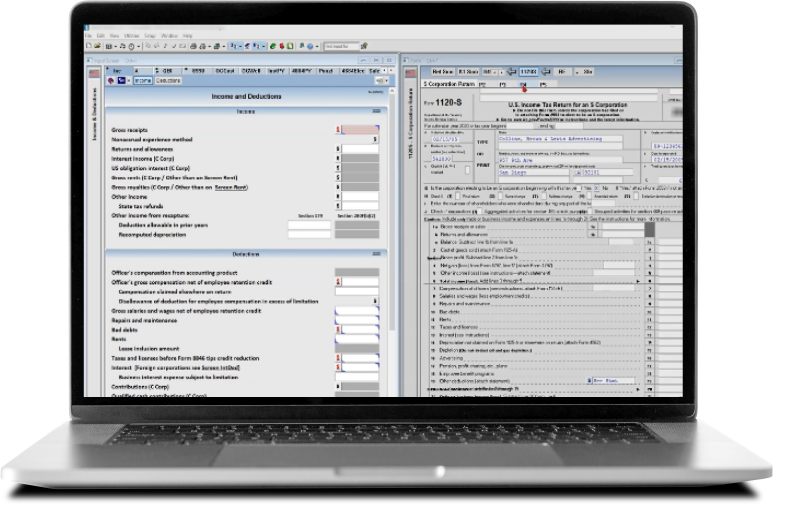Amortization in accounting 101
Learn the different methods to amortize an intangible asset.
Jump to:
Companies have a lot of assets. These assets vary depending on the type of business, but they often include such tangibles and intangibles as office buildings, corporate vehicles, computers, patents, copyrights, and trademarks. There is, however, no one-size-fits all approach when calculating the value of a company’s assets. Some assets will fall under amortization accounting.
Depending on the type of asset — tangible versus intangible — there are differences in the calculation method allowed and how they are presented on financial statements. Understanding these differences is critical when serving business clients.
What is amortization in accounting?
Amortization in accounting is a technique that is used to gradually write-down the cost of an intangible asset over its expected period of use or, in other words, useful life. This shifts the asset to the income statement from the balance sheet.
What are intangible assets? These are non-physical assets like patents, trademarks, licenses, copyrights, lease agreements, customers lists, and internet domain names.
Intangible assets are purchased, versus developed internally, and have a useful life of at least one accounting period. It should be noted that if an intangible asset is deemed to have an indefinite life, then that asset is not amortized.
Since intangible assets are not easily liquidated, they usually cannot be used as collateral on a loan.
To further illustrate amortization accounting, consider the following example:
Example A: A business has a $10,000 software license, which it expects will come to an end in five years. Using the straight-line method, the amortization expense would be $2,000 per year for the next five years. At the end of five years, the carrying amount of the asset will be zero. The amortization period is the amount of time in which the company expects to generate revenue from the license.
Is amortization a liability or expense?
Amortization is a non-cash expense. It is the concept of incrementally charging the cost (i.e., the expenditure required to acquire the asset) of an asset to expense over the asset’s useful life.
So how does this look? It reflects as a debit to the amortization expense account and a credit to the accumulated amortization account.
On the income statement, typically within the “depreciation and amortization” line item, will be the amount of an amortization expense write-off.
On the balance sheet, as a contra account, will be the accumulated amortization account. It is located after the intangible assets line item. In some instances, the balance sheet may have it aggregated with the accumulated depreciation line, in which only the net balance is reflected.
Here’s another example:
A company spends $50,000 to purchase a software license, which will be amortized over a five-year period. The annual journal entry is a debit of $10,000 to the amortization expense account and a credit of $10,000 to the accumulated amortization account.
What is an amortization schedule?
Aside from using amortization to write-down the cost of an intangible asset over its useful life, there is a second situation for amortization — the amortization of bonds or loans, which involves the use of an amortization schedule.
The amortization of loans is the process of paying down the debt over time in regular installment payments of interest and principal. An amortization schedule is a table or chart that outlines both loan and payment information for reducing a term loan (i.e., mortgage loan, personal loan, car loan, etc.).
Each section of the amortization schedule communicates information to the borrower and lender. Key details within the table or chart typically include:
- The amortization period
- The original loan amount
- The interest rate
- The loan balance at each payment
- The proportion of each payment that is made up of interest versus principal
- The total payment amount
A greater portion of earlier payments go toward paying off interest while a greater portion of later payments go toward the principal debt.
What are the different amortization methods?
When it comes to amortization, there is more than one method. The methods include: the straight-line method, declining balance method, double declining balance method, bullet method, and balloon payments.
Note: If evaluated for advances and loans, the methods for depreciation — straight-line, declining balance, and double declining balance — can also apply to amortization. In those instances, the methods of amortization schedule of loans are used.
#1. Straight-line method
This linear method allocates the total cost amount as the same each year until the asset’s useful life is exhausted.
The straight-line amortization formula is: (Book value – expected salvage value) / number of periods = intangible asset amortization
The steps for calculating straight-line amortization are as follows:
- Determine the initial cost of the asset.
- Determine the number of periods. For instance, for trademarks and patents the number of years until they expire is typically used to calculate amortization.
- Determine the salvage value.
- Calculate the straight-line amortization rate.
Consider the following example of a company looking to sell rights to its intellectual property.
Company A purchases intellectual property for $20,000. It plans to sell the rights to Company B after five years for $4,000. Company A then uses the straight-line amortization formula to determine its amortization expense:
Amortization per year = ($20,000 – $4,000) / 5
Amortization per year = $3,200
#2. Declining balance method
This method, also known as the reducing balance method, applies an amortization rate on the remaining book value to calculate the declining value of expenses.
To further illustrate, consider the following example of a declining balance:
Year 1: 50% x $2,000 = $1,000
Year 2: 50% x $1,000 = $500
Year 3: 50% x $500 = $250
Year 4: 50% x $250 = $125
Year 5: 50% x 125 = $62.50
#3. Double declining balance method (DDB)
The double declining method is an accelerated depreciation method. Using this method, an asset value is depreciated twice as fast compared with the straight-line method.
The formula for this method is: 2 X Cost of the asset X Depreciation rate = double-declining balance.
This method is usually used when a business plans to recognize an expense early on to lower profitability and, in turn, defer taxes. Another common circumstance is when the asset is utilized faster in the initial years of its useful life.
In short, the double-declining method can be more complex compared with a straight-line method, but it can be a good way to lower profitability and, as a result, defer taxes.
#4: Bullet method
Using the bullet method recognizes the expense all at once. This method can significantly impact the numbers of EBIT and profit in a given year; therefore, this method is not commonly used.
That being said, the way this amortization method works is the intangible amortization amount is charged to the company’s income statement all at once.
#5. Balloon payments
A balloon payment is the final installment of a loan. The payment is huge and inflated like a balloon, hence the name.
During the loan period, only a small portion of the principal sum is amortized. So, at the end of the loan period, the final, huge balloon payment is made.
These shorter-term loans with balloon payments come with some advantages, such as lower interest rates and smaller initial repayment installments; however, there are some significant disadvantages to consider.
For instance, borrowers must be financially prepared for the large amount due at the end of a balloon loan tenure, and a balloon payment loan can be hard to refinance. Failure to pay can significantly hurt the borrower’s credit score and may result in the sale of investments or other assets to cover the outstanding liability.
How do you calculate amortization?
There are several steps to follow when calculating amortization for intangible assets. Let’s take a closer look.
- The first step is to identify both the basic and residual value. The basic value is the amount that was paid to get the asset. The residual value is that asset’s value at the end of its useful life. For intangible assets, the residual value will be $0.
- Once you have the value, divide that by the years of the intangible asset’s useful life. In other words, the time the business can generate a profit using that intangible asset. Determine the monthly value by dividing the remaining months from the asset value.
- Now, each year, record the value of the asset on the income statement. Then record the decrease in value due to amortization for that year in a separate account titled “accumulated amortization.” This will balance out the asset’s value against its loss in value.
As an example,
A business client develops a product it intends to sell and purchases a patent for the invention for $100,000. It estimates the patent will be useful for five years. On the client’s income statement, it records an asset of $100,000 for the patent. Once the patent reaches the end of its useful life, it has a residual value of $0.
The client divides the value of the patent by the years of its useful life:
$100,000 ÷ 5 = $20,000
Based on this amortization, the income statement after one year shows the following:
| Asset | |
| Patent | $100,000 |
| Accumulated amortization | ($20,000) |
| Net asset value | $80,000 |
What is the maximum number of years for amortization?
Many intangibles are amortized under Section 197 of the Internal Revenue Code. This means, for tax purposes, companies need to apply a 15-year useful life when calculating amortization for “section 197 intangibles,” according the to the IRS.
The IRS noted that businesses “may not be able to amortize section 197 intangibles acquired in a transaction that did not result in a significant change in ownership or use.”
Use Form 4562 to claim deductions for amortization and depreciation.
Is goodwill depreciated or amortized?
Goodwill is amortized. Goodwill is defined as “The residual figure that is recorded on the balance sheet after subtracting the book value of a business from the higher price that was paid for it. Goodwill becomes impaired when its fair value declines below its carrying value.”
Goodwill amortization is when the cost of the goodwill of the company is expensed over a specific period. Amortization is usually conducted on a straight-line basis over a 10-year period, as directed by the accounting standards.
There are, however, a few catches that companies need to keep in mind with goodwill amortization. For instance, businesses must check for goodwill impairment, which can be triggered by both internal and external factors. The goodwill impairment test is an annual test performed to weed out worthless goodwill.
Another catch is that businesses cannot selectively apply amortization to goodwill arising from just specific acquisitions. They must fully adopt a goodwill approach.
Amortization vs. depreciation
Amortization is similar to depreciation but there are some differences. Perhaps the biggest point of differentiation is that amortization expenses intangible assets while depreciation expenses tangible (physical) assets over their useful life.
In short, amortization is associated with intangible assets; depreciation is associated with tangible assets.
Another difference is that the IRS indicates most intangible assets have a useful life of 15 years. Physical or tangible assets may have a shorter useful life. For example, computer equipment can depreciate quickly because of rapid advancements in technology. It should be noted that computer software is an intangible asset.
Managing amortization of assets
Companies have a lot of assets and calculating the value of those assets can get complex.
Turn to Thomson Reuters to get expert guidance on amortization and other cost recovery issues so your firm can serve business clients more efficiently and with ease of mind. By leveraging Thomson Reuters Fixed Assets CS®, firms can effectively manage assets with unlimited depreciation treatments, customized reporting, and more.
Free trialSign up now for a free, cloud-based trial of Fixed Assets CS and begin transforming your practice today. |






